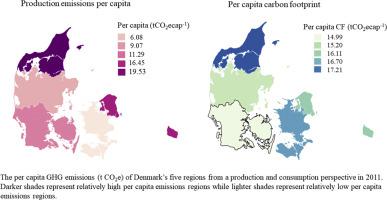当前位置:
X-MOL 学术
›
Ecol. Econ.
›
论文详情
Our official English website, www.x-mol.net, welcomes your feedback! (Note: you will need to create a separate account there.)
Tracking the carbon emissions of Denmark's five regions from a producer and consumer perspective
Ecological Economics ( IF 7 ) Pub Date : 2020-11-01 , DOI: 10.1016/j.ecolecon.2020.106778 Osei-Owusu Kwame Albert , Thomsen Marianne , Lindahl Jonathan , Javakhishvili Larsen Nino , Caro Dario
Ecological Economics ( IF 7 ) Pub Date : 2020-11-01 , DOI: 10.1016/j.ecolecon.2020.106778 Osei-Owusu Kwame Albert , Thomsen Marianne , Lindahl Jonathan , Javakhishvili Larsen Nino , Caro Dario

|
Abstract This paper presents a calculation of Denmark's production and consumption-based accounting CO2e emissions for five regions in 2011. We apply an environmentally extended economic model for Danish municipalities known as the Local “INterregional” Economic (LINE) model, together with a multi-regional input-output model for the world economy (EXIOBASE v3.4). We find that Denmark's Capital region accounts for 41% (28 MtCO2e) and 31% (27 MtCO2e) of Denmark's production and consumption-based emissions respectively. By disaggregating regional emissions into industry and product categories, we provide relevant information to producers and consumers in each region concerning areas where the most significant differences towards reducing their carbon footprint can be realised. Mobility, services, food and shelter were the main drivers of emissions in all Danish regions. The Central, North and South Denmark accounted for more than half (9.56 MtCO2e) of Denmark's food production emissions. The Capital region was the largest source of emissions (3.79 MtCO2e) related to food consumption. We suggest that dietary changes towards less red meat and dairy products can potentially reduce regional food-related emissions of Danish households. Our results indicate that modest changes in consumer lifestyles are pivotal for local climate mitigation policies, especially in Denmark's biggest cities, Copenhagen, Arhus, Aalborg and Odense.
中文翻译:

从生产者和消费者的角度跟踪丹麦五个地区的碳排放
摘要 本文介绍了丹麦 2011 年五个地区基于生产和消费的核算 CO2e 排放量的计算。我们为丹麦城市应用了环境扩展经济模型,称为本地“区域间”经济 (LINE) 模型,以及多世界经济的区域投入产出模型(EXIOBASE v3.4)。我们发现丹麦的首都地区分别占丹麦基于生产和消费的排放量的 41% (28 MtCO2e) 和 31% (27 MtCO2e)。通过将区域排放分解为行业和产品类别,我们向每个区域的生产者和消费者提供相关信息,这些信息涉及可以实现减少碳足迹最显着差异的领域。流动性、服务、食物和住所是丹麦所有地区排放的主要驱动因素。丹麦中部、北部和南部占丹麦食品生产排放量的一半以上(9.56 MtCO2e)。首都地区是与食品消费相关的最大排放源(3.79 MtCO2e)。我们建议减少红肉和乳制品的饮食变化可能会减少丹麦家庭与区域食品相关的排放。我们的结果表明,消费者生活方式的适度变化对于当地气候减缓政策至关重要,尤其是在丹麦最大的城市哥本哈根、奥尔胡斯、奥尔堡和欧登塞。79 MtCO2e) 与食品消费有关。我们建议减少红肉和乳制品的饮食变化可能会减少丹麦家庭与区域食品相关的排放。我们的结果表明,消费者生活方式的适度变化对于当地气候减缓政策至关重要,尤其是在丹麦最大的城市哥本哈根、奥尔胡斯、奥尔堡和欧登塞。79 MtCO2e) 与食品消费有关。我们建议减少红肉和乳制品的饮食变化可能会减少丹麦家庭与区域食品相关的排放。我们的结果表明,消费者生活方式的适度变化对于当地气候减缓政策至关重要,尤其是在丹麦最大的城市哥本哈根、阿尔胡斯、奥尔堡和欧登塞。
更新日期:2020-11-01
中文翻译:

从生产者和消费者的角度跟踪丹麦五个地区的碳排放
摘要 本文介绍了丹麦 2011 年五个地区基于生产和消费的核算 CO2e 排放量的计算。我们为丹麦城市应用了环境扩展经济模型,称为本地“区域间”经济 (LINE) 模型,以及多世界经济的区域投入产出模型(EXIOBASE v3.4)。我们发现丹麦的首都地区分别占丹麦基于生产和消费的排放量的 41% (28 MtCO2e) 和 31% (27 MtCO2e)。通过将区域排放分解为行业和产品类别,我们向每个区域的生产者和消费者提供相关信息,这些信息涉及可以实现减少碳足迹最显着差异的领域。流动性、服务、食物和住所是丹麦所有地区排放的主要驱动因素。丹麦中部、北部和南部占丹麦食品生产排放量的一半以上(9.56 MtCO2e)。首都地区是与食品消费相关的最大排放源(3.79 MtCO2e)。我们建议减少红肉和乳制品的饮食变化可能会减少丹麦家庭与区域食品相关的排放。我们的结果表明,消费者生活方式的适度变化对于当地气候减缓政策至关重要,尤其是在丹麦最大的城市哥本哈根、奥尔胡斯、奥尔堡和欧登塞。79 MtCO2e) 与食品消费有关。我们建议减少红肉和乳制品的饮食变化可能会减少丹麦家庭与区域食品相关的排放。我们的结果表明,消费者生活方式的适度变化对于当地气候减缓政策至关重要,尤其是在丹麦最大的城市哥本哈根、奥尔胡斯、奥尔堡和欧登塞。79 MtCO2e) 与食品消费有关。我们建议减少红肉和乳制品的饮食变化可能会减少丹麦家庭与区域食品相关的排放。我们的结果表明,消费者生活方式的适度变化对于当地气候减缓政策至关重要,尤其是在丹麦最大的城市哥本哈根、阿尔胡斯、奥尔堡和欧登塞。



























 京公网安备 11010802027423号
京公网安备 11010802027423号